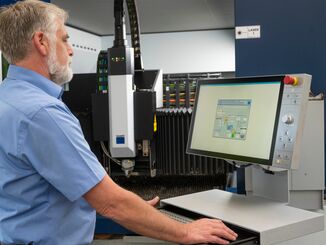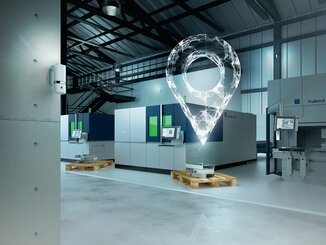
Trumpf increases the degree of automation and process speed of its additive manufacturing technologies and provides new applications for printing pure copper and precious metals with the “green laser”. The presentation of these developments took place at the virtual Formnext 2020.
Klaus Parey, Managing Director responsible for Additive Manufacturing at Trumpf: “The market for additive technologies remains very attractive for Trumpf. In particular, our TruPrint 1000 with green laser beam source is receiving a lot of attention in industrial applications. To melt pure copper and precious metals, short-wave green laser light is the best choice.” In recent months, Trumpf has decisively developed its products and solutions in the field of additive technologies and is relying on a broad product portfolio and a wide variety of materials.
Process speed: New nozzle doubles coating rate
Brake discs, hydraulic or sealing cylinders are components that are often provided with corrosion or wear protection. This metallic coating is achieved by laser cladding. The process, also known as Laser Metal Deposition (LMD), has proven its worth over many years. It delivers high-quality results and produces coatings that are virtually free of cracks and pores.
The so-called area rate, i.e. the speed of the coating, is typically between 10 and 50 square centimetres per minute in the standard LMD process. The high-speed variant of LMD, also known as EHLA, achieves between 250 and 500 square centimeters per minute in today’s industrial environment.

© Trump
Trumpf has now succeeded in increasing the area rate to well over 600 square centimeters per minute with the aid of a new nozzle technology. Depending on the application, speeds of up to 1000 square centimetres per minute are even possible. How does that work? With more powder, more laser power and an industrial-grade nozzle design. Because in order to achieve a higher area application rate, more powder is needed on the one hand. More powder, in turn, means you also have to melt it fast enough. This is why, on the other hand, higher laser powers – up to 8 kilowatts – are necessary.
However, in order to be able to use these high laser powers, a robust, well cooled nozzle is also necessary. It is precisely this interplay that Trumpf combines in its new nozzle technology, which enables significantly higher area rates than before, especially for rotationally symmetrical components.
Automation: New de-powdering station increases degree of purity
To further increase productivity in additive manufacturing, Trumpf is working intensively on optimizing the upstream and downstream work steps in the entire process chain. A new depowdering station for the powder bed-based production process Laser Metal Fusion (LMF) combines two process steps in one system: the unpacking and the depowdering of 3D-printed metal components.
What was previously done manually by a machine operator with the aid of suction nozzles and brushes can now be done much more easily and partly automatically with the new de-powdering station, especially for complex components. The system turns the finished printed component upside down and, if necessary, also begins to vibrate until the component is almost completely free of residual powder. Thus, the new de-powdering process leads to a significantly higher degree of cleaning of the components.
Another advantage is that the machine operator is protected from hazardous dust, as the component remains in the inert chamber flooded with inert gas until the residual powder has been removed.
Material diversity: green makes copper, gold and platinum possible
Two years ago at Formnext, Trumpf demonstrated for the first time how pure copper and precious metals can be printed using a green wavelength disk laser. This is because copper and gold, for example, strongly reflect the infrared wavelength used in conventional 3D printers, making the melting process impossible. The green wavelength is significantly shorter than the infrared wavelength, making it possible to 3D print pure copper and precious metals.
Trumpf has now successfully established the TruPrint 1000 Green Edition on the market and is enjoying resounding success. For example, Trumpf customer Toolcraft uses it to produce components for various industries, and the company C. Hafner uses it to build watch cases made of red gold and platinum. Trumpf’s “green printers” are also running at full speed at the Fraunhofer IWS, where several institutes are working with the TruPrint 1000 Green Edition in various research areas.



